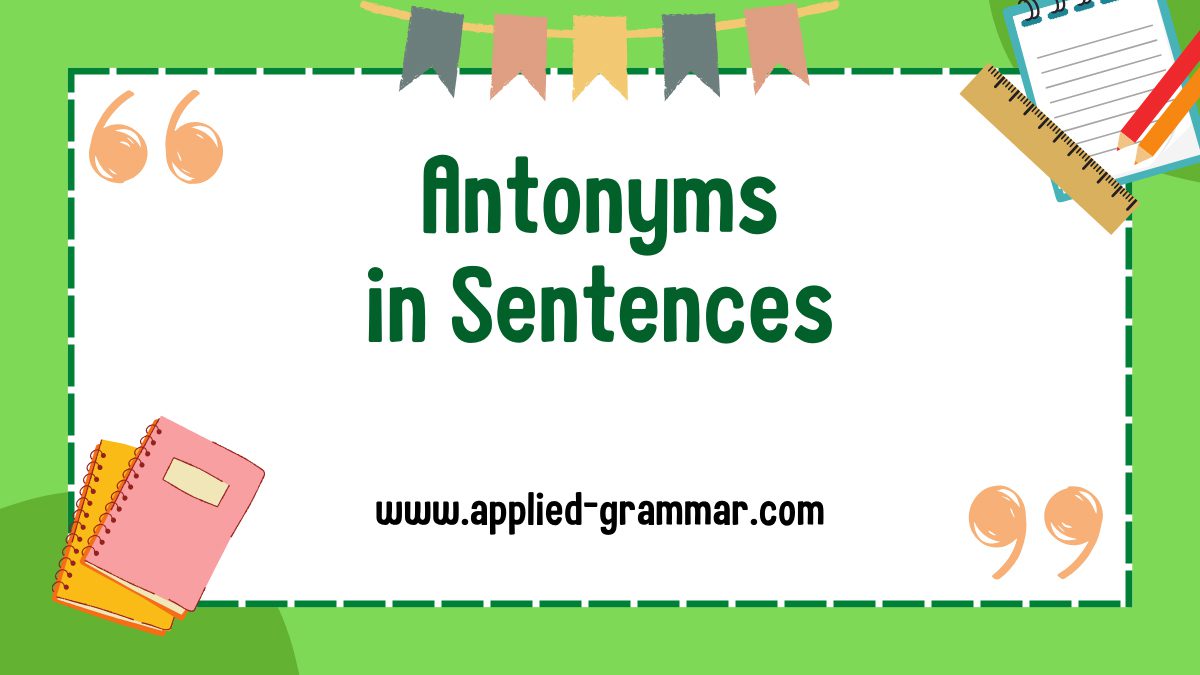Do you want to take your writing to the next level? Are you looking for a way to add more depth and nuance to your sentences? Well, look no further than the power of antonyms. Antonyms, or words that have opposite meanings, can be a game-changer when it comes to enhancing your writing.
In this text, we will explore how incorporating antonyms in sentences can elevate your writing and make it more engaging. Whether you’re a student looking to impress your teachers or a professional writer aiming to captivate your readers, understanding the art of using opposites is a valuable skill.
By incorporating antonyms, you can add layers of meaning and create a more vivid and dynamic experience for your readers. Not only do antonyms provide contrast and balance, but they also allow you to express complex ideas in a concise and impactful manner. So, if you’re ready to take your writing to new heights, let’s jump into the world of antonyms and discover how they can transform your sentences.
Key Takeaways
- Using antonyms in sentences can greatly enhance your writing by adding depth, nuance, and contrast.
- Antonyms provide balance, create a natural flow, and catch the reader’s attention.
- Incorporating antonyms in your writing can expand your vocabulary and improve your language skills.
- Antonyms can be used to create contrast and emphasis, highlight differences, and draw attention to key ideas.
- Antonyms can add depth and nuance to descriptions, creating a more engaging and impactful experience for the reader.
- Avoid common mistakes when using antonyms, such as using unrelated antonyms, overusing antonyms for emphasis, and using antonyms inappropriately.
The Importance of Using Antonyms in Sentences

Enhancing Writing with Opposites
Using antonyms in sentences is a powerful technique that can greatly enhance your writing. By incorporating opposites, you can add depth, nuance, and contrast to your sentences, making them more engaging and impactful. Opposites provide a balance and allow for the expression of complex ideas in a concise and dynamic manner.
When you use antonyms in sentences, you create a natural flow that catches the reader’s attention and keeps them interested. Antonyms create a sense of contrast and tension, making your writing more vivid and compelling. For example, instead of simply saying “the day was sunny,” you can add depth to your sentence by saying “the day was bright and sunny, but my mood was dark and gloomy.” This contrast not only paints a more detailed picture for your reader but also adds an emotional element to your writing.
Expanding Vocabulary
Plus to enhancing your writing, using antonyms in sentences can also expand your vocabulary. Antonyms provide you with a range of words that have opposite meanings, allowing you to express yourself more effectively. By knowing the opposite of a word, you can choose the right word to convey your intended meaning and avoid ambiguity.
By incorporating antonyms in your writing, you can enrich your vocabulary and improve your language skills. As you explore different antonyms and their meanings, you’ll discover new ways to express yourself and communicate your ideas more precisely. This not only makes your writing more diverse but also allows you to convey complex thoughts and emotions with clarity and precision.
Summarizing, using antonyms in sentences is a powerful tool that can elevate your writing and enhance your language skills. By incorporating opposites, you can create a more engaging and impactful experience for your readers. So, don’t hesitate to discover the area of antonyms and embrace the power of contrast in your writing.
Techniques for Using Antonyms in Sentences

Finding the Right Antonyms
When incorporating antonyms in your sentences, it is crucial to find the right ones to create the desired impact. Here are a few techniques to help you find the perfect antonyms:
- Word Associations: Think about words that are opposite in meaning to the word you want to use. For example, if you want to describe something as “small,” you can consider using antonyms like “big,” “large,” or “enormous.”
- Thesaurus Exploration: Use a thesaurus to discover synonyms and antonyms for your chosen words. This will expand your vocabulary and provide you with a wide range of options to add depth and contrast to your sentences.
- Contextual Understanding: Consider the context of your sentence and the message you want to convey. Choose antonyms that enhance the meaning and impact of your writing.
Creating Contrast and Emphasis
Antonyms are a powerful tool for creating contrast and emphasis in your sentences. By juxtaposing opposite words, you can effectively highlight differences and draw attention to key ideas. Here’s how to use antonyms to create contrast and emphasis:
- Sentence Structure: Use antonyms to create parallel sentence structures. For example, “She was overjoyed, while he was utterly devastated.” This contrast in emotions creates a powerful impact.
- Sentence Placement: Place antonyms side by side or in close proximity to highlight differences. For instance, “The room was filled with laughter and silence.” This contrast between two contrasting states adds emphasis to the silent atmosphere.
Adding Depth and Nuance to Descriptions
Antonyms can add depth and nuance to your descriptions, making them more engaging and impactful. Here’s how to incorporate antonyms to enhance your descriptions:
- Vivid Imagery: Use antonyms to paint a vivid picture in the reader’s mind. For example, instead of just describing a beautiful sunset, you can say, “The sky was ablaze with vibrant oranges and deep purples, creating a striking contrast with the darkening silhouette of the mountains.”
- Character Development: Use antonyms to highlight contrasting traits in your characters, creating depth and complexity. For instance, you can describe a character as “confident yet vulnerable” or “kind-hearted with a hint of cynicism.”
Incorporating antonyms in your sentences allows you to create a natural flow that catches the reader’s attention and keeps them interested. Discover the area of antonyms to elevate your writing and create a more engaging and impactful experience for your readers.
Examples of Using Antonyms in Sentences

Antonyms for Adjectives
When it comes to enhancing your writing with antonyms, adjectives can play a crucial role in adding depth and contrast to your sentences. By using antonyms for adjectives, you can describe different qualities or attributes in a way that creates a vivid and engaging experience for your readers.
Consider the following examples:
- “The day was bright and sunny, but my mood was dark and gloomy.”
- “The room was quiet, except for the sound of my heart pounding.”
In these examples, the antonyms “bright/dark” and “sunny/gloomy” create a stark contrast, painting a clear picture of the emotions and atmosphere in the scene. By using antonyms, you can effectively convey opposing qualities and create a more dynamic narrative.
Antonyms for Verbs
Verbs are the action words that drive your sentences and give life to your writing. By incorporating antonyms for verbs, you can emphasize contrasting actions and create a more engaging reading experience.
Here are a few examples:
- “She jumped into the water, while he chose to plunge into the depths.”
- “He tried to justify his actions, but she was quick to accuse him.”
In these examples, the antonyms “jump/plunge” and “justify/accuse” showcase opposing actions and highlight the tension or conflict in the narrative. By using antonyms for verbs, you can add a layer of complexity to your writing and keep your readers captivated.
Antonyms for Nouns
Nouns are the building blocks of your sentences, and by using antonyms for nouns, you can convey contrasting concepts or ideas. This can help to enhance the overall impact of your writing and bring more depth to your descriptions.
Consider the examples below:
- “The glittering jewel stood in stark contrast to the humble bauble.”
- “The pursuit of justice was overshadowed by the prevailing injustice.”
In these examples, the antonyms “jewel/bauble” and “justice/injustice” highlight opposing concepts and emphasize the stark differences between them. By incorporating antonyms for nouns, you can create vivid imagery and convey contrasting qualities or characteristics.
Using antonyms in your writing allows you to add nuance, contrast, and depth to your sentences. Whether it’s through antonyms for adjectives, verbs, or nouns, these examples demonstrate how leveraging opposites can elevate your writing and engage your readers. So, embrace the power of antonyms and enhance your writing through the art of contrast.
Common Mistakes to Avoid when Using Antonyms in Sentences

Incorrect Word Usage
Using antonyms in sentences can be a powerful way to add depth and contrast to your writing. But, it’s important to be mindful of using the correct antonyms to convey your intended meaning. Here are some common mistakes to avoid:
- Using unrelated antonyms: Make sure that the antonyms you choose are truly the opposite of the original word in meaning. Using antonyms that are unrelated or only partially opposite can confuse your readers and weaken the impact of your sentence.
- Using ambiguous antonyms: Some words have multiple antonyms with different meanings. Be careful when choosing antonyms that you are using the one that accurately represents the opposite meaning you want to convey.
- Using overly technical or rare antonyms: While it’s great to expand your vocabulary, using obscure or technical antonyms can disrupt the flow of your writing and make it less accessible to your readers. Opt for antonyms that are commonly understood and easily recognizable.
Overusing Antonyms for Emphasis
Antonyms can be a powerful tool for adding emphasis to your writing, but it’s important to use them judiciously. Here are some common pitfalls to avoid:
- Overusing antonyms in every sentence: While using antonyms can make your writing more engaging, overusing them can make it feel forced and repetitive. Instead, focus on using antonyms strategically to create impact when it really matters.
- Using antonyms as a substitute for strong description or storytelling: Antonyms should complement your writing, not replace it. Don’t rely solely on antonyms to convey your message or create vivid imagery. Instead, use them as part of a well-crafted narrative or description to enhance the overall effect.
Using Antonyms Inappropriately
To make the most of antonyms in your writing, it’s important to use them appropriately and in a way that enhances your message. Here are some common mistakes to avoid:
- Using antonyms without considering context: Antonyms rely heavily on context. Make sure that the antonym you choose is suitable and appropriate for the particular sentence or paragraph you are writing. Consider the tone, style, and overall message of your writing to ensure that the antonym fits seamlessly.
- Using antonyms without considering the effect on the reader: Antonyms can create a strong emotional response in your readers. Keep in mind the impact that the antonym will have on your audience and use it to create the desired effect, whether it’s surprise, contrast, or emphasis.
- Using antonyms without clear purpose: Every word in your writing should serve a purpose. Before incorporating an antonym, ask yourself how it enhances your message or brings additional depth to your writing. If the antonym doesn’t serve a specific purpose, consider using other techniques or words instead.
By being mindful of these common mistakes, you can effectively use antonyms in your writing to enhance your message, engage your readers, and create a more impactful experience.
Conclusion
Incorporating antonyms in sentences can significantly enhance your writing by adding depth, nuance, and contrast. By utilizing opposites, you can make your sentences more engaging and impactful, capturing the attention of your readers.
Finding the right antonyms can be achieved through various techniques, such as word associations, exploring thesaurus options, and understanding the context. These methods allow you to select antonyms that effectively create contrast and emphasis within your sentences.
Antonyms can add depth and nuance to descriptions, enabling you to create vivid imagery and highlight contrasting traits in characters. Whether you’re using antonyms for adjectives, verbs, or nouns, they can help you create a compelling contrast that captivates your audience.
But, it’s important to avoid common mistakes when using antonyms. Ensure that the antonyms you choose are related and clear, avoiding ambiguity. Also, be cautious not to overuse antonyms for emphasis or rely solely on them instead of strong description and storytelling.
By using antonyms appropriately and purposefully, you can enhance the overall message of your writing and create a more impactful experience for your readers. So, embrace the power of antonyms and take your writing to new heights.
